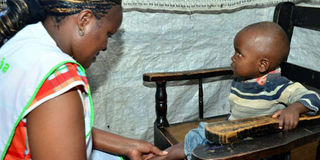Nairobi has the highest number of children with rickets - study

Poverty, severe malnutrition and swaddling babies blamed for high cases of vitamin D deficiency in Nairobi and central Kenya. PHOTO| FILE| NATION MEDIA GROUP
When paediatrician colleagues told Mike English that they were seeing a lot of rickets cases in Kenya, he got together with other researchers to find out just how common the problem was, especially because rickets is not considered a major public health problem in the country.
The result was one-year analysis of hospital records of 20,528 children aged one month to five years, admitted at 13 hospitals in three regions of Kenya, done by researchers from the Kenya Medical Research Institute-Wellcome Trust Research Programme (KWTRP), and released mid-August.
NAIROBI HAS THE HIGHEST OCCURENCE
They found that 4.01 per cent of children in two Nairobi hospitals had rickets and 0.92 per cent of children in six hospitals in the highland or semi-arid parts of central Kenya had rickets, an ailment marked by soft and weak bones leading to bone deformities as a result of lack of vitamin D.
Only one out of 9,756 children admitted in six hospitals in western Kenya had rickets. Factors such as maternal and child nutrition, urbanisation and cultural practices might explain these differences in regional rickets cases.
For instance in western Kenya where nutrient-rich indigenous vegetables and fish (dagaa) are consumed regularly or added to weaning flours to make porridge, rickets was less common.
In central Kenya on the other hand, where diets are cereal-based with little diversity and early weaning on cereal porridge, infants were deprived of proteins and micronutrients found in human milk, thus predisposing them to mineral deficiencies, such as rickets and anaemia.
Swaddling of babies in the colder regions of central Kenya, such as in Nyeri whose temperatures in the coldest months drop to lows of 10°C, as compared to warmer weather in the western region where the coldest month yields lows of 22°C in Kisumu, was also associated with rickets.
In the warmer regions, children are minimally clad and thus more exposed to sunlight which prevents rickets. In the same vein, the study found a link between pneumonia in central Kenya and rickets.
VITAMIN D AND CALCIUM DEFICIENCIES
Rickets occurs when children and their mothers have diets low in vitamin D – an essential nutrient for healthy bones — is made when human skin is exposed to sunlight or obtained from the diet. It also controls the amount of calcium in blood
Interestingly, dark skin synthesises vitamin D at a slower rate than lighter skin. Therefore, children in low-income sub-Saharan African countries, where there is plenty of sunlight almost all year long, are perhaps paradoxically some of the most susceptible to rickets.
Vitamin D and calcium deficiencies have a major impact on the health of infants, children, and adolescents.
Lack of the two nutrients is known to lead to growth retardation, muscle weakness, skeletal deformities, hypocalcaemia (lower than average levels of calcium in the blood and can lead to memory loss, body numbness, and depression), tetany (muscular problems), and seizures.
Symptoms include: Ribs with the appearance of a chain of rosary beads running down the chest, bow legs, bone pain on walking, swollen knees and wrist widening.
PRONE TO DEFICIENCY
There are people who are prone to vitamin D deficiency. They include:
- pregnant and breastfeeding mothers
- women with multiple pregnancies
- infants
- adolescents
- people who are obese
- dark-skinned people
- wearing concealing clothing
- immobility, such as inpatients
- excessive use of sun block
- vegetarians and vegans
- prolonged breastfeeding even if mother has sufficient Vitamin D
- people on exclusion diets
- people with malabsorption illnesses
- people with liver disease
- people with renal disease
- taking some drugs such as anti-seizure drugs, tuberculosis drugs
A diet rich in vitamin D from fatty fish like tuna; egg yolks, cheese, beef liver; calcium from milk, kales, sardines (omena), and phosphates 4, 5 found in bread, cereals and brown rice, can help prevent rickets.
The study reviewed hospital records of children admitted in county hospitals under the Clinical Information Network Initiative, which supports better data collection on hospitalised children.
“Our findings are just from hospitals, but suggest the problem may be common in the communities, especially in highly urbanised settings such as Nairobi, perhaps linked to poverty,” said Dr English, a paediatrician from the UK.
“Knowing the scale of the problem is important as rickets is largely preventable with appropriate nutrition or by giving simple supplements,” he added.
Notably, the findings only captured more obvious cases of rickets that were apparent to doctors. Given that most hospitals do not have routine diagnostic tests for vitamin D deficiency, milder cases might be even more common.
The study recommends targeted public health interventions such as improved use of calcium or vitamin D supplements in pregnant and lactating mothers, infant supplementation or food fortification, to prevent rickets.
Source: Royal College of Paediatrics and Child Health



